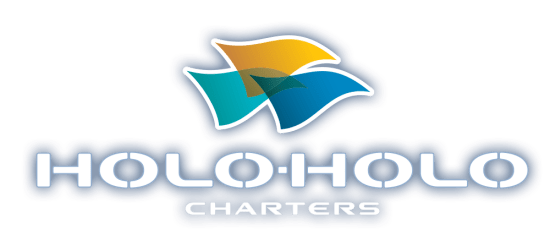Hawaiian Language 101

‘Ōlelo Hawai‘i or the Hawaiian language lies at the core of our local culture here on Kauaʻi, and throughout the Hawaiian islands. You will notice a plethora of Hawaiian words integrated into menus, business names, street names, and everyday conversation in Hawaiʻi. Fittingly, Holo Holo Charters is named after the Hawaiian word holoholo, which means to go for a walk, a stroll or a sail. Not to be confused with pidgin (local slang,) ‘ōlelo Hawai‘i comes from the indigenous people of Hawaiʻi, dating back to (and prior to) when Hawaiʻi was a thriving monarchy. Often intimidating at first glance, the pronunciation of Hawaiian words are surprisingly easier than you’d think once you’re familiar with the diacritical marks and the general rule of thumb–pronounce everything.
Pronunciation and cultural significance
You may notice that the street names here on Kauaʻi are filled with diacritical marks. This is of course to aid the pronunciation of the roads, often tied to the historical significance of the area; but it is also to honor the correct pronunciation of Hawaiian words. We value our visitors, and have confidence that they are here to both respect and learn about the rich history of our sacred islands. Many people come to Hawaiʻi looking for a “local experience,” and that begins with understanding the culture and language.

Although we always use the proper diacritical marks in our printed materials, the internet has not completely caught up. Unfortunately, not all servers are able to produce accurate diacritical marks for our online readers, which can result in confusing filler text like question marks or boxes which don’t display the text as it was intended. If you do notice that we have omitted diacritical marks from our online materials, it’s because we are trying to streamline our visitors’ online experience, not because we do not recognize the importance of diacritical marks to the Hawaiian language.
Here is a brief introduction to the basics of the Hawaiian language:
With half the letters of the traditional English alphabet, the Hawaiian alphabet consists of only 13 letters – five vowels (A, E, I, O, U,) and eight consonants (H, K, L, M, N, P, W and the ʻokina.)
The two diacritical marks that affect both pronunciation and meaning:
‘Okina – Often confused as a backwards apostrophe, the ‘okina indicates a stop or break between vowels. For example, peʻe is pronounced peh-eh, (not pee) given the break between the vowels.
Kahakō – As opposed to the English language (which kind of keeps you guessing,) Hawaiian marks its long vowels with a macron–a bar above the letter to indicate emphasis and lengthen the pronunciation of the letter marked. (Ex: Nāpali Coast is pronounced Nuh-pah-lee Coast.)
A common example of how drastically diacritical marks can drastically change the meaning of a word is with the word pau.
 Pau: finished
Pau: finished
Pa’u: soot
Pa’ū: damp
Pā’ū: skirt
…so yeah, grammatical accuracy matters.
Key Hawaiian Words and Phrases
Aloha – Hello, goodbye, all encompassing love, kindness and compassion.
Mahalo – Thank you.
‘A’ ole pilikia (ah-oh-leh pee-lee-kee-yah) – You’re welcome.
Pono (poh-no) – To do good or act with righteousness. Hawaiʻi’s state motto is “Ua Mau Ke Ea o ka ‘Aina i ka Pono” which means “The life of the land is perpetuated by righteousness.” Learn more via our pono pledge.
A hui hou (ah-hoo-wee-ho) – Until we meet again/goodbye.
Howzit?
 Hawaiian pidgin dates back to the plantation days, a result of native Hawaiians, foreign immigrants, and English-speaking transplants communicating on sugar plantations. As with all geographical dialects, influences spanned from all of the countries that now make up the majority of inhabitants here in Hawaiʻi. English, Filipino, Chinese, Japanese, Korean, Portuguese, Korean and more heavily influenced the locally spoken language as the islands became more of a melting pot with the rise of the sugar cane industry. Here are some common pidgin phrases:
Hawaiian pidgin dates back to the plantation days, a result of native Hawaiians, foreign immigrants, and English-speaking transplants communicating on sugar plantations. As with all geographical dialects, influences spanned from all of the countries that now make up the majority of inhabitants here in Hawaiʻi. English, Filipino, Chinese, Japanese, Korean, Portuguese, Korean and more heavily influenced the locally spoken language as the islands became more of a melting pot with the rise of the sugar cane industry. Here are some common pidgin phrases:
Howzit? A common greeting to ask how someone is doing. It’s the combination of the words “how,” “is” and “it.”
Brah – Short for brother or braddah, this is a casual way to refer to someone.
Da kine – This one comes in handy because it’s a catch all for anything you can’t remember the name of!
Broke Da Mouth – This is a way to describe incredible food (which we have plenty of here!) You may also hear the term ʻono to describe the same thing. *Pro-tip: If you see Broke Da Mouth poke, get it.
Hana Hou – If you see live music while in Hawaiʻi you will likely hear the crowd chanting “ha-nuh-ho!” This is the Hawaiian equivalent of an encore.
By taking the time to learn a bit more about the Hawaiian language, you are effectively keeping an almost extinct language alive. At one point ‘ōlelo Hawai‘i was almost completely abandoned due to colonization and the oppression of native Hawaiian culture. As a cherished piece of history, we invite you to join us to preserve the Hawaiian language by sharing it for years to come.
